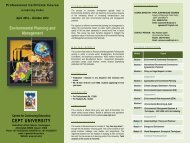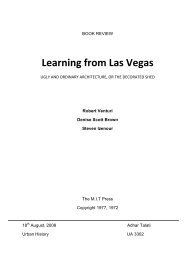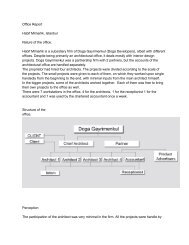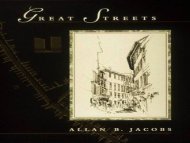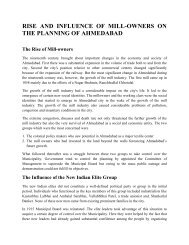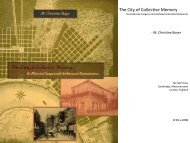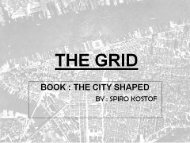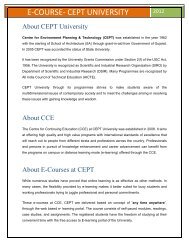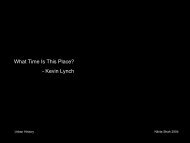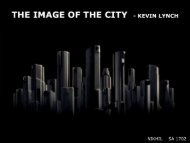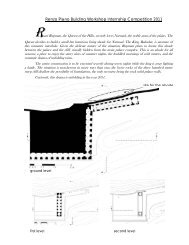sample question paper 2
sample question paper 2
sample question paper 2
Create successful ePaper yourself
Turn your PDF publications into a flip-book with our unique Google optimized e-Paper software.
TEST [revision + <strong>sample</strong> <strong>question</strong> <strong>paper</strong>]<br />
5 th October 2011 ARCHITECTURAL RESEARCH METHODS SEM I: 2011‐12<br />
PART A<br />
Read the research proposal given below carefully and answer the following.<br />
Q1. What is unclear in the aim of the proposal? (5)<br />
Q2. Critique the validity of the objectives in relation to the stated aim. (5)<br />
Q3. What is missing and what is unnecessary in the introduction of the proposal? (5)<br />
Q4. Critique each of the 3 points mentioned in scope and limitation separately. (5)<br />
Research Proposal<br />
Introduction: The need for shelter is as old as man himself. Since time<br />
immemorial man has been trying to build a shelter to respond to his specific needs.<br />
Society has become much more complex and this relation between needs and shelter<br />
has changed. Culture is a very important part of any society. Different people have<br />
different cultures and this is evident in the houses that they build. It is therefore<br />
necessary to study this relation between culture and house‐form.<br />
Patan, an ancient fortified town, was founded in 745 AD by Vanraj Chavda, the most<br />
prominent king of the Chavda Kingdom. He named the city Anhilpur Patan or<br />
"Anhilwad Patan" after his close friend and Prime Minister Anhil shepherd. It is<br />
variously referred to in Sanskrit literature as Anahilpatak, Anahipattan, Anahilpur,<br />
Anahilvad Pattan, Pattan etc. These Chalukya rajputs, with Paramaras of Malwa, the<br />
Chauhans of Sakambhari and Chandellas of Kalanjar and Mahoba, were serious<br />
contestants for supremacy in northern India. At the zenith of their imperial greatness<br />
the bounds of Gujarat were extended to cover Saurashtra and Kutch in the West,<br />
Lata in the South, Malwa in the East and Southern Rajasthan in the North.<br />
Historian Tertius Chandler estimates that Anhilwara was the tenth‐largest city in the<br />
world in the year 1000, with a population of approximately 100,000.<br />
Aim: To study the physical form of Brahmin streets by understanding relation<br />
between culture and behaviour<br />
Objectives:<br />
1. To understand the traditional Brahmin houses of Patan<br />
2. To study how the soci‐cultural aspect affects evolution of house form<br />
3. To study the issue of changes in the built environment<br />
Methodology:<br />
Initially the study will focus on understanding the concepts of house form, streets,<br />
and space making elements through secondary sources. Study will try to understand<br />
the place using secondary sources on Patan. This will be followed by a study of the<br />
history of Brahmins through interviews and secondary sources, a study of culture and
TEST [revision + <strong>sample</strong> <strong>question</strong> <strong>paper</strong>]<br />
5 th October 2011 ARCHITECTURAL RESEARCH METHODS SEM I: 2011‐12<br />
built form of streets through documentation, and understanding the urban fabric and<br />
structure through observation.<br />
Scope and Limitation:<br />
1. This study is limited to the Brahmin streets of the old city of Patan<br />
2. Only traditional buildings using old construction methods are selected<br />
3. The main focus will be on the physical aspects and character of space only<br />
PART B<br />
Answer the following <strong>question</strong>s based on this thought process for conducting research.<br />
I keep looking trees and I think that architecture and cities can be explained by<br />
comparing it with a tree. Not all trees are the same; there are shrubs, flowering and<br />
non‐flowering plants, evergreen and deciduous trees and yet they have so much in<br />
common. I could also study it at various scales‐ leaves, twigs, and trunk; as various<br />
systems‐ food and water cycles, growth and decay etc.; as form and pattern; or as<br />
material and structure.<br />
Q1. What, according to you, are the advantages of following such a thought process to begin<br />
research? Suggest a substantially different way of starting research. (5)<br />
Q2. State 2 different research topics based on this train of thought. The research is to be conducted<br />
in the field of ‘built environment studies.’ (5)<br />
Q3. Write the aim/hypothesis for one of the above mentioned research topics. (5)<br />
Q4. Show one <strong>sample</strong> of analysis for this research. Analysis could be in the form of drawings,<br />
diagrams, text, and charts. (5)



